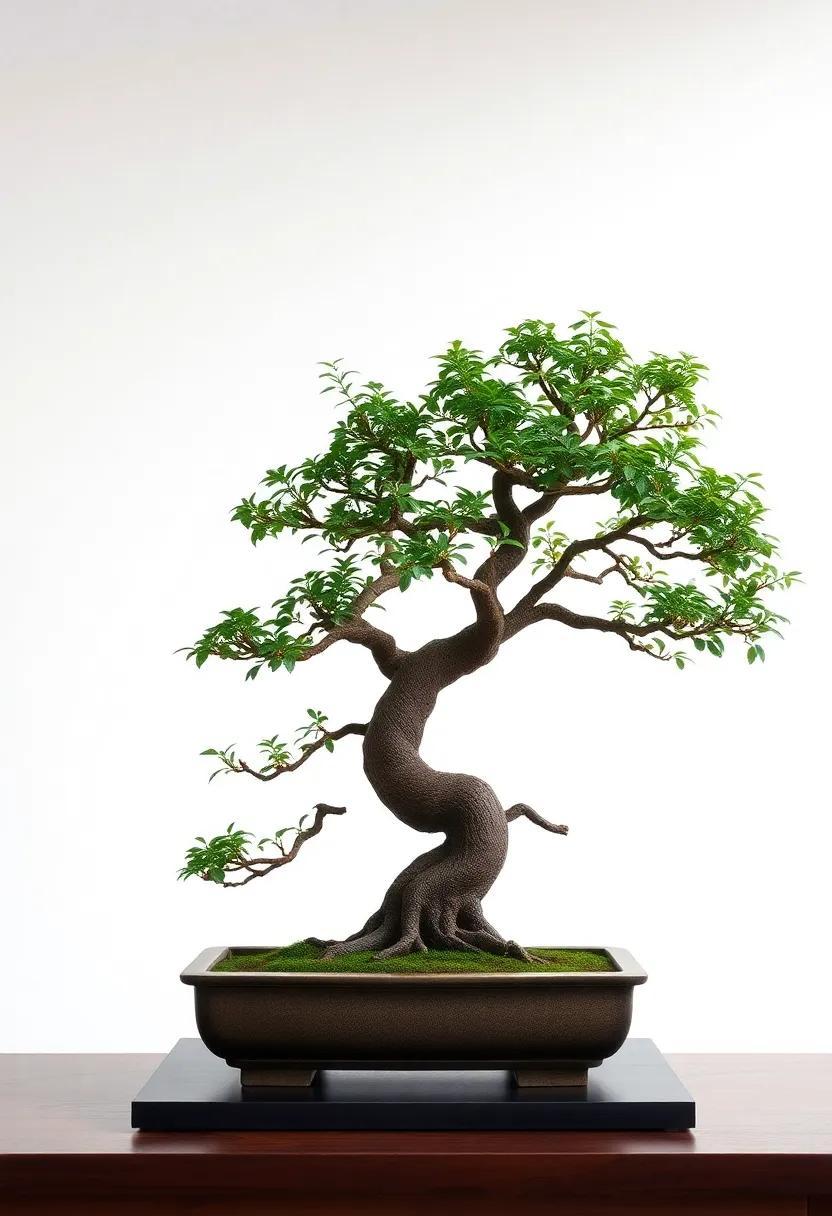
Indoor vs. Outdoor Bonsai Trees: Unveiling Their Unique Worlds and Care Tips
In the serene art of bonsai, nature’s miniature masterpieces unfold, inviting enthusiasts into a world where patience and precision reign supreme. As the delicate branches of these tiny trees twist and turn, thay beckon us to explore the unique realms of indoor and outdoor bonsai cultivation. Each surroundings offers its own set of challenges and rewards, creating distinct ecosystems that shape the growth and aesthetic of these living sculptures. Whether you find solace in the tranquility of a well-tended indoor garden or prefer the embrace of fresh air amidst nature’s beauty, understanding the nuances of indoor and outdoor bonsai care is essential for nurturing these resilient flora. Join us as we delve into the captivating contrasts between indoor and outdoor bonsai trees, revealing essential care tips that will help you flourish in your bonsai journey.
Exploring the essential Differences Between Indoor and Outdoor Bonsai Trees

Bonsai trees offer a captivating glimpse into nature’s artistry, yet the needs of indoor and outdoor varieties differ considerably. Indoor bonsai trees thrive in stable environments where temperature and humidity can be controlled, frequently enough lacking the cold dormancy required by their outdoor counterparts. These trees are typically smaller, making them suitable for living rooms and offices. Common indoor species include:
- Ficus – Resilient and forgiving, ideal for beginners.
- Jade – Known for its thick, succulent leaves and easy maintenance.
- Pine – Adapts well to indoor conditions with adequate light.
Conversely, outdoor bonsai trees require exposure to varying weather conditions and seasonal changes. These trees usually display more significant growth and can become impressive specimens over the years. They need a period of dormancy to promote healthy progress, making them ideal for garden or balcony displays. Popular outdoor varieties include:
- Maple – Recognized for its stunning fall colors and elegant structure.
- Pine – Valued for its rugged aesthetic and robustness.
- Juniper – Offers a classic silhouette and hardy nature.
the Fascinating Variety of Bonsai species for Indoor environments

Bonsai enthusiasts are frequently enough taken by the rich tapestry of species that thrive indoors. Each variety brings its own charm,making it essential to choose wisely based on your home environment and personal aesthetic.Some remarkable options include:
- Ficus Bonsai: Renowned for its hardy nature and adaptability,this species can handle lower light conditions,making it perfect for indoor spaces.
- Chinese Elm: This delightful species is resilient and fast-growing, with a beautiful leaf structure that adds elegance to any room.
- Pine Bonsai: While often associated with outdoor settings, certain pine species can flourish indoors with the right care and lighting.
- Jade Plant (Crassula): A succulent that adapts well to indoor growth, it brings a unique texture and vitality to your bonsai collection.
Understanding the unique care requirements of each species is vital to maintaining their health indoors. Factors such as lighting, humidity, and watering schedules vary, and incorporating these needs into your care routine can make all the difference. Consider this handy comparison:
| Species | Light Requirement | Watering Frequency |
|---|---|---|
| Ficus Bonsai | Luminous, indirect light | Once a week |
| Chinese Elm | Moderate light | Every 5-7 days |
| Pine Bonsai | Bright light | Every 2 weeks |
| Jade Plant (Crassula) | Bright light | Once every 2 weeks |
Perfecting the Art of Bonsai Potting: Indoor vs. Outdoor Approaches

The potting process for bonsai involves a keen understanding of the unique needs of your indoor or outdoor varieties. Indoor bonsai trees,frequently enough housed in a controlled environment,benefit from a well-draining soil mix that retains moisture yet allows excess water to escape. When potting, consider using a pot that has drainage holes and is slightly oversized to accommodate the tree’s root system. A suggested mix includes components like akadama, lava rock, and organic potting soil, ensuring adequate aeration and nutrient stability.
In contrast, outdoor bonsai require a different potting approach. These trees are more resilient to weather fluctuations and thus can thrive in a coarser soil mix that provides excellent drainage to prevent root rot during rainy seasons. If potting outdoor varieties, choose deeper pots to encourage root spread and include elements such as gravel, pumice, and sand for optimal drainage. Utilizing a pot that is both sturdy and weather-resistant will help your outdoor bonsai endure the varied conditions of nature.
Understanding Climate Requirements for Optimal Bonsai Growth

When nurturing bonsai trees, it is essential to recognize the distinct climate requirements that support their optimal growth, whether indoors or outdoors. Outdoor bonsai often thrive in conditions influenced by natural daylight, temperature fluctuations, and seasonal changes. This environment allows the tree to engage in a natural dormancy period, which is critical for its overall health and development. Key factors include:
- Sunlight: Most outdoor bonsai varieties necessitate full sun exposure, ideally for six hours a day.
- Humidity: Open-air environments generally provide adequate humidity levels, aiding in moisture retention.
- Temperature: Hardier species can withstand colder conditions, while tropical varieties require warmth and protection during winter.
Conversely, indoor bonsai must adapt to controlled conditions, frequently enough lacking the natural light and humidity essential for growth. To mimic an ideal habitat,owners should provide supplemental lighting,regularly mist the leaves,and monitor room temperatures. Consider the following care elements for indoor varieties:
- Light requirements: Utilize grow lights to simulate natural sunlight, particularly during shorter days.
- Watering: Maintain consistent moisture without overwatering, as indoor conditions can lead to rapid drying.
- air Circulation: Keep indoor bonsai in a location with good airflow, crucial for preventing pests and promoting healthy growth.
Creative Indoor Spaces: Styling Your Bonsai Tree for Maximum Impact
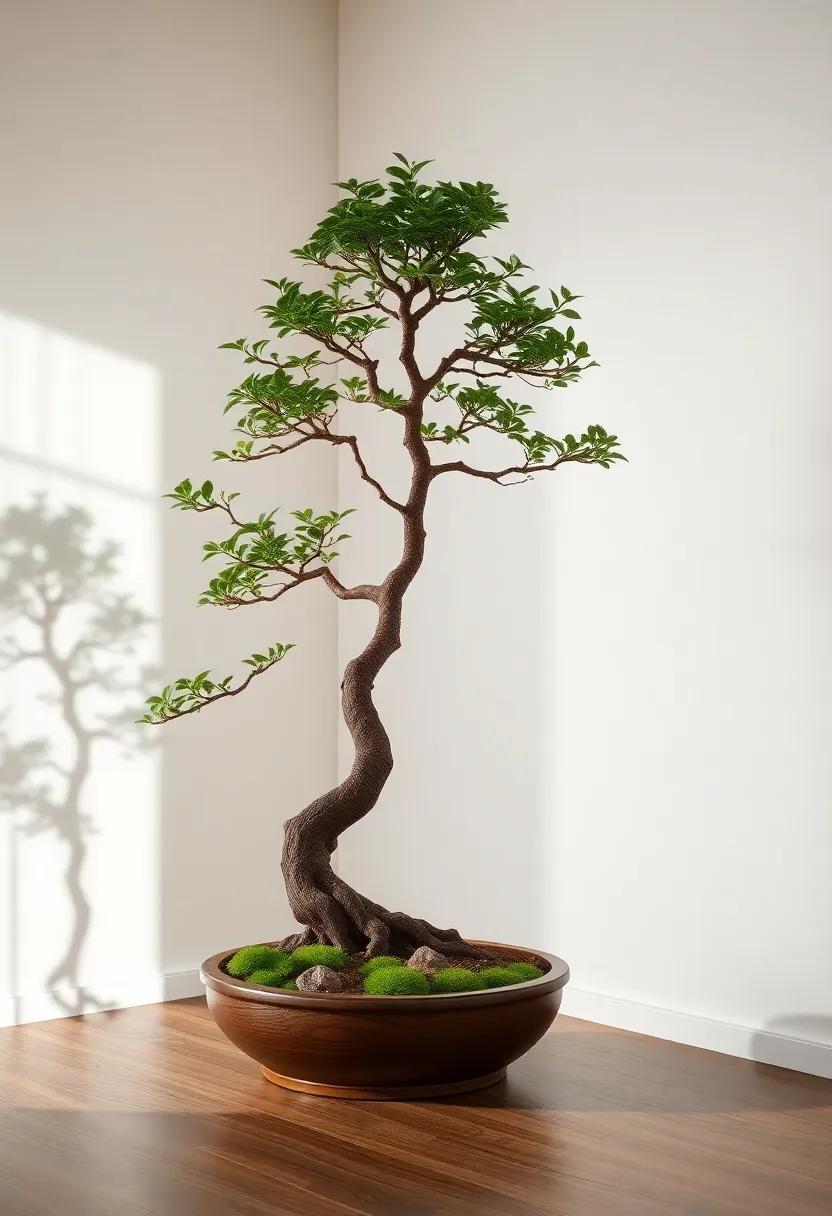
Transforming your indoor environment with the serene elegance of a bonsai tree requires more than just placement; it’s about styling and showcasing its unique beauty. Begin by selecting a decorative pot that complements the tree’s character. Consider using pots made from natural materials like clay or ceramic, which can enhance the organic feel of your indoor bonsai. Surround the base of your bonsai with natural moss, pebbles, or miniature figurines that reflect your personal taste. This adds an artistic touch and provides a contrast to the vibrant greens,emphasizing the intricate details of the tree. Additionally, utilize LED accent lighting to cast soft glows on the bonsai, highlighting its textured bark and foliage, and creating a calming ambiance in your space.
Incorporating your bonsai into a larger aesthetic design can elevate its presence and impact significantly. Create a cohesive theme by positioning your bonsai within a curated indoor garden setup. Use shelf displays to layer different heights, allowing each bonsai to stand out while maintaining harmony with companion plants. An open shelf unit can serve as a stage where you can rotate different bonsais throughout the seasons,ensuring each one gets its moment to shine. Moreover,consider a minimalist approach with color-coordinated decor around your bonsai; choose furniture and accessories that draw from the colors within the tree’s foliage or blossom to create a seamless visual flow. your indoor bonsai does not just thrive as a plant; it becomes a living piece of art that breathes life into your space.
choosing the Right Soil for Your Indoor and Outdoor Bonsai Trees

When it comes to cultivating bonsai trees, the choice of soil is crucial in ensuring the health and longevity of both indoor and outdoor varieties. Indoor bonsai trees typically thrive in a well-draining mix that retains adequate moisture yet allows excess water to escape. Recommended components for indoor soil include:
- Akadama: A clay-like mineral that retains moisture and provides nutrients.
- pumice: adds aeration and retains some water without becoming soggy.
- Orchid bark: enhances drainage and promotes healthy root growth.
On the other hand, outdoor bonsai frequently enough benefit from a soil mix designed to withstand the elements and encourage root expansion. Components tailored for outdoor bonsai trees may include:
- Loam: A balanced mixture that provides fertility and moisture retention.
- Gravel: Enhances drainage and prevents root rot during rainy seasons.
- Compost: Adds nutrients and beneficial microorganisms to the soil.
to visually aid in your understanding of these differing soil needs, the table below summarizes the key attributes of soil for indoor and outdoor bonsai trees:
| Feature | Indoor Bonsai | Outdoor Bonsai |
|---|---|---|
| Moisture Retention | Moderate | Variable |
| Nutrient Content | Higher | Natural |
| Drainage | Excellent | Good |
Light Requirements: Balancing Sunlight and Shade for Bonsai Health

Understanding the light needs of bonsai trees is crucial for their growth and vitality. Indoor bonsai trees generally require bright, indirect sunlight. Placing them near a south or west-facing window is ideal, as it provides ample light without exposing them to harsh conditions. On the other hand, outdoor bonsai benefit from direct sunlight, frequently enough thriving with at least six hours of light per day. However, during peak summer months, providing some shade during the hottest part of the day can help prevent leaf burn and stress.
When setting up your bonsai care routine, consider these key variables:
- Variety: Different species have unique light preferences; tropical varieties frequently enough enjoy more indirect light, while conifers thrive in direct sun.
- Season: seasonal changes can affect light intensity; monitor your bonsai closely as the days get shorter or longer.
- location: Rotate your bonsai regularly to ensure all sides receive ample light exposure, preventing uneven growth.
Here’s a fast comparison of light requirements:
| Bonsai Type | Light Preference | Ideal Placement |
|---|---|---|
| Indoor | Bright, indirect light | Near south/west-facing window |
| Outdoor | direct sunlight (6+ hours) | Open area with some shade |
The Role of Humidity in Indoor Bonsai Care and Preservation
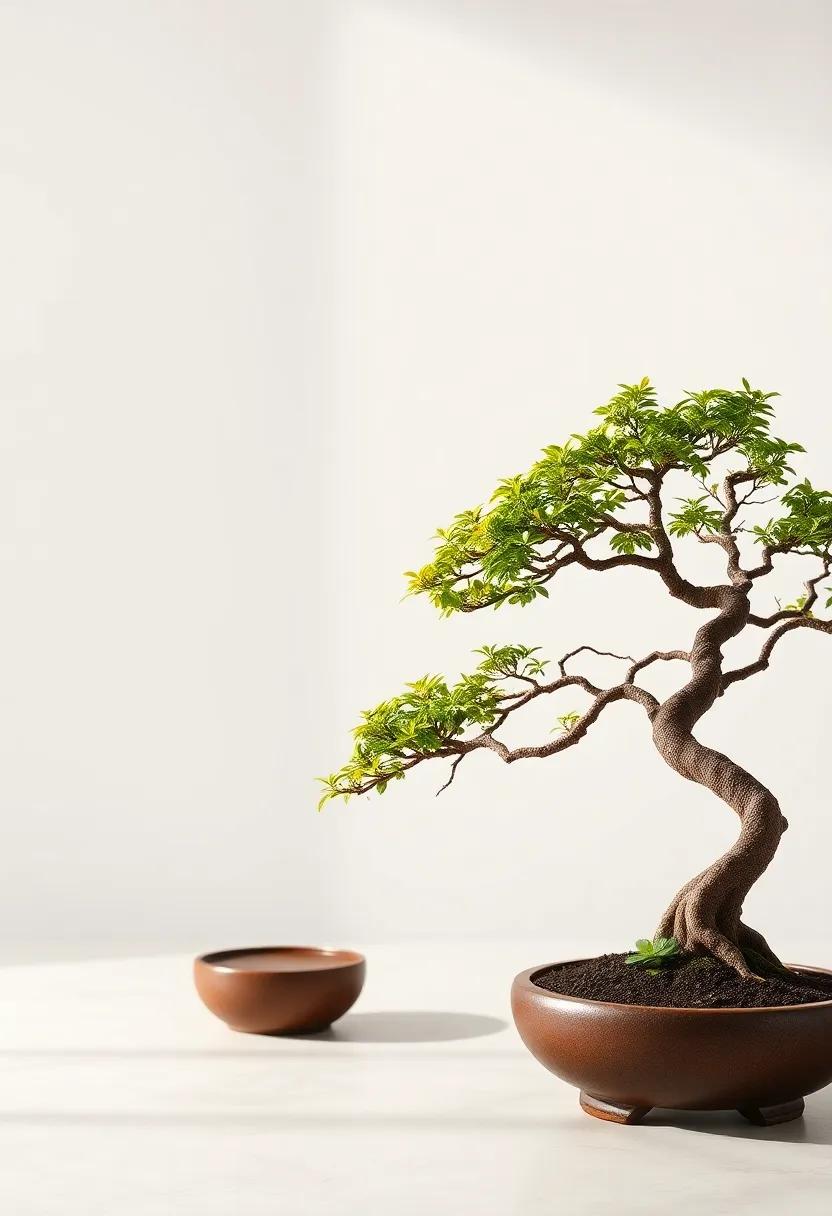
Humidity plays a crucial role in the health and vitality of indoor bonsai trees,often overlooked by novice enthusiasts. Unlike their outdoor counterparts that benefit from natural environmental conditions, indoor bonsai are exposed to climate-controlled settings where humidity levels can significantly fluctuate. Maintaining an optimal level of humidity is essential for preventing stress in these delicate plants. A low humidity environment can lead to issues such as leaf drop or browning, while excessive humidity can foster fungal diseases. Therefore, monitoring and adjusting humidity levels is key to ensuring a thriving indoor bonsai ecosystem.
To effectively manage humidity, consider the following methods:
- Humidity trays: Fill shallow trays with water and pebbles. Place your bonsai pot on top, allowing humidity to rise around the plant.
- Regular misting: Lightly mist the leaves daily to artificially boost humidity levels.
- Essential humidifiers: Use a small room humidifier, especially in dry climates or during winter months.
In addition, keep an eye on the specific needs of your bonsai species, as different varieties may require varying humidity levels. Below is a simple guideline for common indoor bonsai trees:
| Bonsai Type | Ideal Humidity |
|---|---|
| Ficus | 40-60% |
| Juniper | 30-50% |
| Pine | 40-70% |
| Acer (Maple) | 50-70% |
Seasonal Changes: How They Affect Your Bonsai’s Environment

As the seasons shift, so does the environment in which your bonsai trees thrive.Indoor bonsai are largely sheltered from extreme weather changes,with regulated temperature and humidity that create a stable habitat.Though,this controlled environment can lead to issues like low light availability,particularly during winter months when natural sunlight decreases. to ensure your indoor bonsai remains healthy, consider implementing grow lights and monitoring moisture levels closely. With consistent care, you can mimic the natural growth cycle your tree would experience outdoors.
On the other hand, outdoor bonsai face a dynamic array of seasonal changes, providing both challenges and opportunities for growth. For these trees, the transition from spring to summer means increased sunlight and warmth, which can enhance their vigor. However, as fall approaches, it’s essential to prepare them for the eventual chill. Strategies include relocating your bonsai to a more protected spot and insulating their pots to safeguard against extreme temperatures.To provide a complete overview, here’s a comparison of essential care considerations based on the seasons:
| Season | Indoor Bonsai Care | Outdoor Bonsai Care |
|---|---|---|
| spring | Increase watering; provide indirect sunlight | Repot if necessary; ensure proper drainage |
| summer | Monitor moisture; avoid direct sunlight | Protect from extreme heat; allow for well-ventilated spaces |
| Fall | Reduce watering; prepare for dormancy | Start winter preparation; protect roots from frost |
| Winter | Maintain humidity; use a thermostat | Cover or move to a sheltered area; limit watering |
Watering Techniques: Indoor vs.Outdoor Bonsai Considerations

Watering techniques for bonsai trees vary significantly between indoor and outdoor settings, largely due to differences in environmental conditions. Indoor bonsai, frequently enough in controlled climates, require consistent moisture levels. It’s essential to monitor the potting soil’s dryness, typically checking every few days. The use of a moisture meter can be beneficial, allowing you to gauge when the tree needs water. Consider these techniques for indoor watering:
- Daily misting: Helps to maintain humidity and prevent drying out.
- Submerging pots in water: Occasionally immersing pots for short periods allows the soil to absorb moisture evenly.
- Drip watering systems: For long-term convenience, small drip systems can provide consistent moisture without oversaturation.
In contrast, outdoor bonsai are exposed to natural elements, necessitating a more adaptable watering approach. Factors such as temperature, humidity, and sunlight exposure dictate watering frequency. Unlike their indoor counterparts, outdoor trees may dry out faster, especially during hot spells.Here are some effective strategies for outdoor watering:
- Deep watering: Encourages deep root growth by saturating the soil thoroughly less frequently.
- Morning watering: Reduces evaporation loss while allowing the tree to absorb moisture throughout the day.
- Rainwater collection: Utilizing collected rainwater is ideal for maintaining a balanced nutrient level.
Pest Management Strategies Unique to Indoor and Outdoor Bonsai

Pest management strategies vary significantly between indoor and outdoor bonsai,reflecting the distinct environments they inhabit. Indoor bonsai trees, shielded from many natural predators, are susceptible to common household pests like spider mites, aphids, and mealybugs. Effective management often involves regular inspection, ensuring a clean environment, and introducing beneficial insects such as ladybugs. Keeping humidity levels balanced is crucial, as indoor conditions can be dry. Implementing homemade insecticidal soaps or neem oil sprays can also help maintain a pest-free zone without harming the delicate balance of indoor ecosystems.
In contrast, outdoor bonsai face a multitude of pests due to their exposure to the natural environment. Leafhoppers, caterpillars, and scale insects are potential threats that outdoor enthusiasts must monitor closely. To safeguard these trees, proactive measures like companion planting can deter harmful species by attracting beneficial insects.Additionally, employing physical barriers such as fine mesh netting can protect bonsai from larger pests such as birds and rodents. Regular pruning not only promotes healthy growth but also allows for early detection of pest infestations, making management more efficient.
Pruning Practices: Crafting the Perfect Shape for Your Bonsai

Pruning is the lifeblood of bonsai cultivation, allowing enthusiasts to sculpt their trees into living art. This process involves not just cutting back unwanted branches but also shaping and encouraging growth in specific directions.When pruning, it’s essential to understand the balance between maintaining the tree’s health and achieving the desired aesthetic. Each cut should be purposeful, promoting a natural appearance while adhering to the principles of proportion and form. Regular trimming sessions not only refine the bonsai’s shape but also stimulate new growth, keeping the tree vibrant and robust.
For both indoor and outdoor bonsai, different pruning techniques may apply based on the species and environmental context.When pruning, consider the following tips to achieve flawless results:
- Timing: Prune during the early growing season to allow for optimal recovery and growth.
- Tools: Always use sharp, clean tools to prevent damage and disease transmission.
- Technique: Use the “cut and grow” method to encourage forgiving new shoots, while avoiding harsh reductions that can shock the tree.
Additionally, maintaining a pruning schedule can help track when to make cuts based on seasonal growth patterns. A simple table can assist in monitoring key pruning tasks:
| Season | pruning Focus |
|---|---|
| Spring | Structural pruning for shape and style |
| Summer | Maintenance trimming of new growth |
| Autumn | Light shaping to prepare before winter |
| Winter | Minimal to avoid stressing the tree |
The Importance of Fertilization: What Every Bonsai Owner should Know

Fertilization is a critical aspect of maintaining both indoor and outdoor bonsai trees, as it directly impacts their growth, health, and overall vitality. Understanding the specific nutritional needs of your bonsai is essential, as different species require varied types of fertilizers to thrive.While indoor bonsai trees may benefit from more frequent feeding due to the controlled environment that limits natural nutrient availability, outdoor bonsai can frequently enough extract nutrients from the soil. However, their fertilization needs change with the seasons, and recognizing these differences can be beneficial for optimal growth.
Here are some tips to ensure your bonsai receives the right nutrients:
- Type of Fertilizer: Use a balanced fertilizer designed for bonsai, ensuring it contains essential macronutrients (nitrogen, phosphorus, potassium) and micronutrients.
- Frequency: Indoor bonsai typically need fertilization every 4-6 weeks during the growing season,while outdoor varieties may only require 2-4 feedings.
- Request Method: Consider using liquid, granular, or slow-release fertilizers, depending on your bonsai’s specific requirements and your personal preference.
- Timing: Fertilize during the spring and summer when your bonsai is actively growing; reduce or eliminate feeding during the fall and winter dormant periods.
Harnessing Natural Elements: How to Enhance Outdoor Bonsai Growth
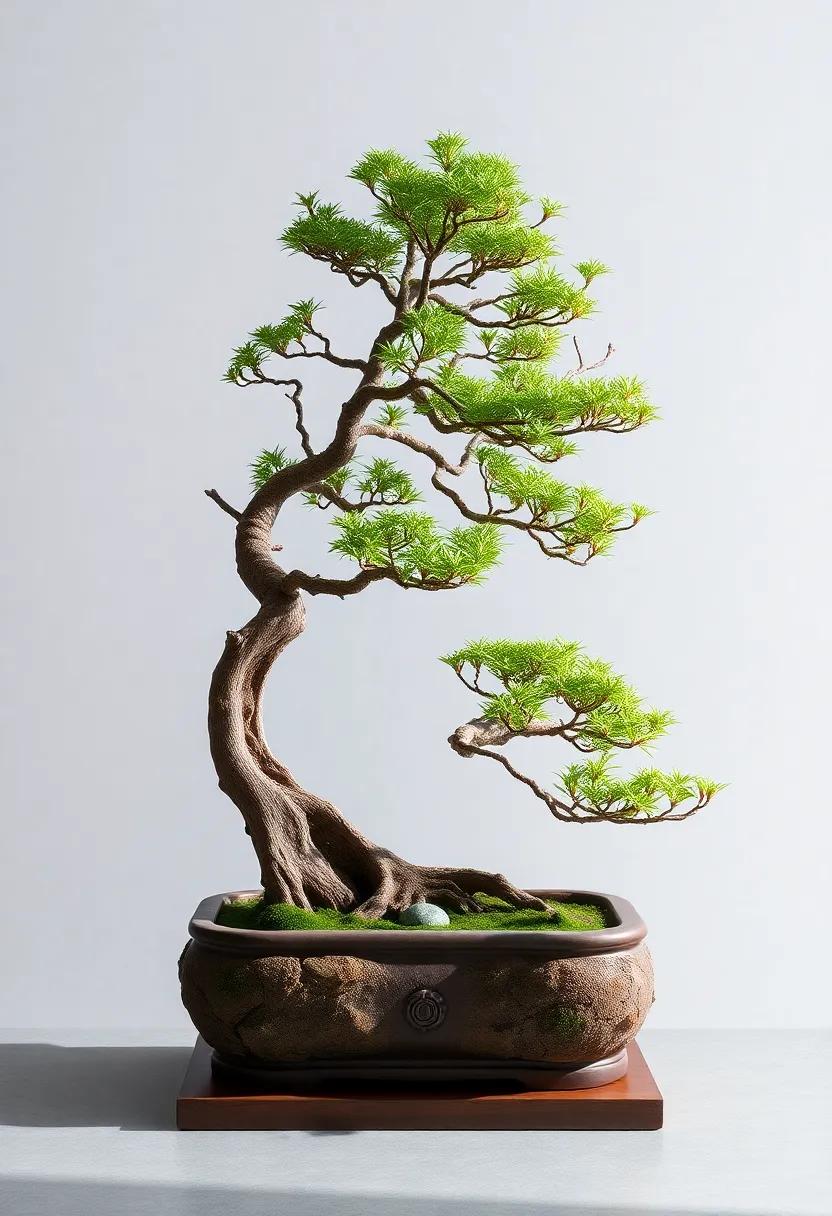
To cultivate thriving outdoor bonsai, it is essential to leverage the natural elements that surround them. Sunlight is a crucial component, and the orientation of your bonsai ensures it receives the right amount of light. An ideal spot allows your tree to bask in the gentle morning sun while being shaded from the harsh afternoon rays. Additionally, consider the importance of airflow; proper ventilation encourages healthy growth and helps prevent diseases. When selecting a location, observe the microclimate of your garden and tailor your care approach based on these subtle environmental cues.
Watering your outdoor bonsai requires a delicate balance influenced by seasonal changes and weather conditions. During warmer months, ensure the soil remains adequately moist without becoming waterlogged, as this can lead to root rot. conversely, in cooler seasons, reduce watering frequency allowing the soil to dry out a bit between sessions. Here are key aspects to keep in mind:
- Soil Quality: Use well-draining soil to prevent oversaturation.
- Pest Management: Regularly check for pests; introduce beneficial insects like ladybugs.
- Fertilization: Apply a balanced fertilizer during the growing season to boost nutrient availability.
Monitoring the bonsai’s exposure to rain can also be vital. A sudden downpour could damage delicate branches, so consider temporary coverings during storms. to help illustrate care tips for various bonsai species, refer to the simple guidelines below:
| Bonsai Species | Light Requirements | Watering Needs |
|---|---|---|
| Juniper | Full sunlight | Moderate; allow soil to dry between waterings |
| Pine | Partial shade | Low; water less frequently |
| Maple | Filtered sunlight | Consistent moisture; keep soil damp |
The Seasonal Beauty of Outdoor Bonsai: Capturing Nature’s Change
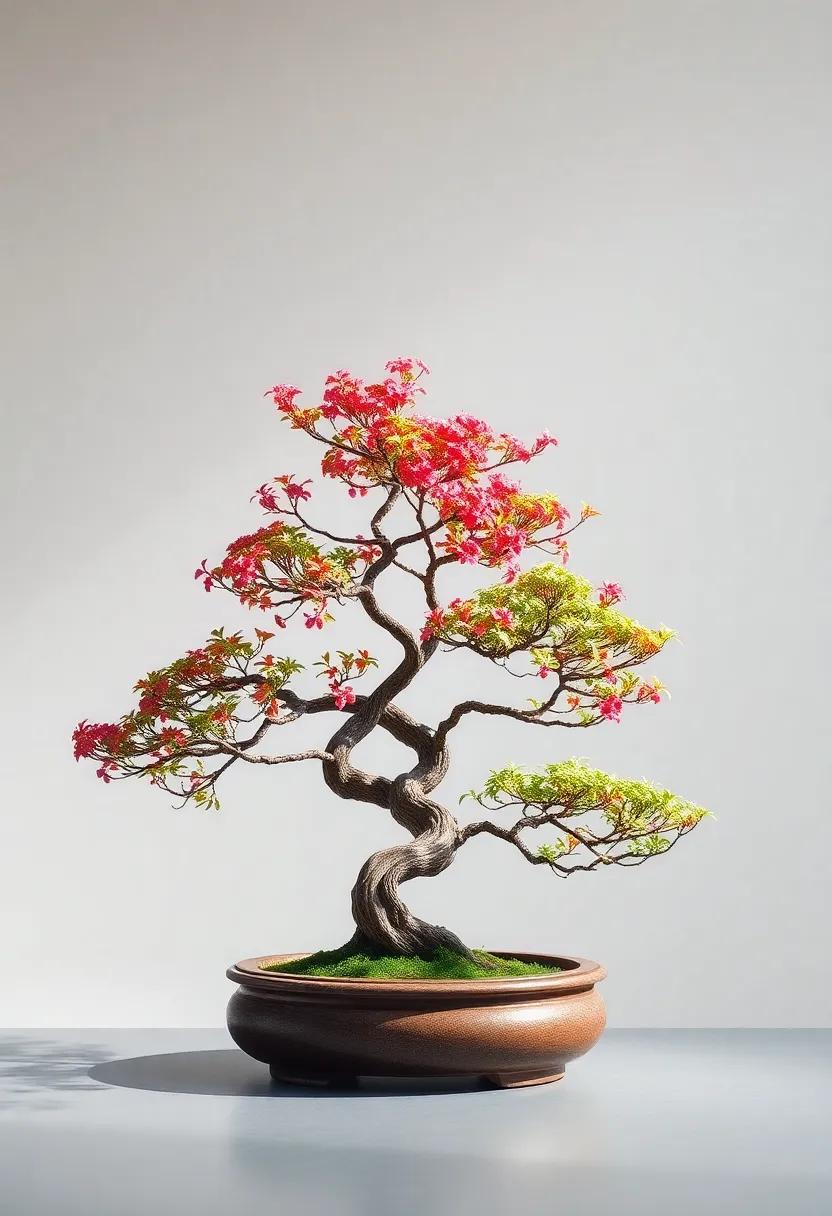
The allure of outdoor bonsai is accentuated by the vibrant shifts in season,each bringing a unique layer of beauty to these miniature trees. In spring, bonsai awaken from dormancy, showcasing delicate blossoms and fresh green leaves that symbolize renewal. As summer arrives, the foliage flourishes, providing lush canopies and rich color variations that enhance the overall visual appeal.The transition into autumn transforms the landscape, as many species burst into a spectacle of reds, oranges, and yellows—each tree a living palette of color, welcoming the crisp air and shorter days.
Winter tells a different story; the bareness of branches reveals the intricate artistry of each tree’s structure, allowing enthusiasts to appreciate their form like never before. Here are some characteristics of outdoor bonsai throughout the seasons:
| Season | Characteristics | Care Tips |
|---|---|---|
| Spring | New growth, blooming flowers | Prune as needed; fertilize |
| Summer | Lush foliage, vibrant colors | Ensure adequate water; provide shade |
| Autumn | Colorful leaves; preparation for dormancy | Reduce watering; protect from frost |
| Winter | Bare branches; structural beauty | Minimize watering; cover from snow and ice |
Caring for Your Bonsai During Winter: Insights for Indoor and Outdoor Trees

Caring for bonsai trees during winter requires a tailored approach, as indoor and outdoor varieties face different challenges. For indoor bonsai, maintaining appropriate humidity levels is crucial. Indoor heating can dry the air, so consider placing a humidity tray filled with water near your tree or using a room humidifier. It’s also important to reduce watering frequency, as indoor trees typically need less moisture during this dormant period. Position your bonsai in a spot where it can receive indirect sunlight and away from heating vents or drafty windows.
Outdoor bonsai trees, on the other hand, necessitate a different strategy to withstand the elements. Mulching is recommended to protect the roots from freezing temperatures. You may also need to place your bonsai in a sheltered area to shield it from harsh winds and snow.Keep an eye on moisture levels; while outdoor trees may need watering during mild spells, be cautious not to overwater. For additional protection, consider wrapping the pot with burlap or bubble wrap to insulate against extreme cold.
The Meditative Experience of bonsai: Finding Peace with Your Green Companion

The act of nurturing a bonsai tree transcends mere horticulture, becoming a meditative endeavor that connects us to nature on a profound level. Each moment spent shaping its branches and caring for its roots invites a quiet reflection, allowing us to immerse ourselves in the present. As you trim the foliage or rearrange the soil, you cultivate not just your green companion but also a serene state of mind that can alleviate the stresses of daily life. The ritual of bonsai care becomes a form of mindfulness, where the intricate details of the tree mirror the complexities within ourselves. Through this patient process, we learn the art of letting go, understanding that growth often takes time and diligence.
Whether you choose an indoor or outdoor bonsai, the techniques and environment can deeply influence your meditative experience. Indoor bonsai often thrive in a controlled setting, benefiting from the gentle touch of artificial light and humidity, which can create a tranquil nook in your home. Outdoor bonsai, on the other hand, are in constant dialog with the elements, embracing the seasons and their inherent unpredictability. Here are some key differences to consider in your care routine:
| Aspect | Indoor Bonsai | Outdoor Bonsai |
|---|---|---|
| Light needs | Indirect sunlight, grow lights | Full sunlight, natural daylight |
| watering | Check moisture frequently | Depends on rainfall and season |
| Temperature | Stable, warm conditions | Varies with the seasons |
| Humidity | Higher humidity, misting required | Natural outdoor humidity |
incorporating these practices into your bonsai routine not only nurtures the tree but also cultivates a sanctuary of peace. Each bonsai becomes a living testament to patience, resilience, and the beauty of nature, inviting you to pause, breathe, and find solace in its gentle presence. By fostering a bond with your bonsai, you can transform your space into a tranquil oasis, attuned to the cycles of life unfolding through your leafy companion.
To Conclude
As we conclude our exploration of the captivating realms of indoor and outdoor bonsai trees, it becomes clear that both environments offer unique opportunities for connection, creativity, and care.Whether you find your peace tending to a miniature marvel thriving in the cozy embrace of your living room or prefer the vitality of a majestic species dancing with the elements outside, the art of bonsai invites you into a world where nature and nurture collide. Each tree tells a story, shaped by your hands and the environment it calls home. By understanding the distinct needs and characteristics of both indoor and outdoor bonsai, you can embark on a fulfilling journey that transcends mere gardening. So, choose your path, nurture your green companion, and let the ancient practice of bonsai inspire mindfulness and joy in your daily life. After all, every tree is not just a plant but a living piece of art waiting to flourish under your care. Happy bonsai-ing!
As an Amazon Associate I earn from qualifying purchases.



